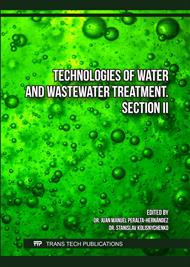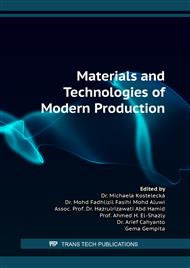[1]
A. M. Mustafa, T. G. Poulsen, Y. Xia, and K. Sheng, Bioresource Technology Combinations of fungal and milling pretreatments for enhancing rice straw biogas production during solid-state anaerobic digestion,, Bioresour. Technol., vol. 224, p.174–182, 2017,.
DOI: 10.1016/j.biortech.2016.11.028
Google Scholar
[2]
A. I. A. Elhamid, M. Emran, M. H. El Sadek, A. A. El, and S. Hesham, Enhanced removal of cationic dye by eco ‑ friendly activated biochar derived from rice straw,, Appl. Water Sci., vol. 10, no. 1, p.1–11, 2020,.
DOI: 10.1007/s13201-019-1128-0
Google Scholar
[3]
M. Fawzy, M. Nasr, A. M. Abdel-Rahman, G. Hosny, and B. R. Odhafa, Techno-economic and environmental approaches of Cd2+ adsorption by olive leaves (Olea europaea L.) waste,, Int. J. Phytoremediation, vol. 21, no. 12, p.1205–1214, 2019,.
DOI: 10.1080/15226514.2019.1612848
Google Scholar
[4]
M. Inyang, B. Gao, P. Pullammanappallil, W. Ding, and A. R. Zimmerman, Bioresource Technology Biochar from anaerobically digested sugarcane bagasse,, Bioresour. Technol., vol. 101, no. 22, p.8868–8872, 2010,.
DOI: 10.1016/j.biortech.2010.06.088
Google Scholar
[5]
J. Laramee, S. Tilmans, and J. Davis, Costs and bene fi ts of biogas recovery from communal anaerobic digesters treating domestic wastewater : Evidence from peri-urban Zambia,, J. Environ. Manage., vol. 210, p.23–35, 2018,.
DOI: 10.1016/j.jenvman.2017.12.064
Google Scholar
[6]
R. Abdel, M. Mahmoud, and J. B. Van Lier, Toward achieving sustainable management of municipal wastewater sludge in Egypt : The current status and future prospective,, Renew. Sustain. Energy Rev., vol. 127, no. May, p.109880, 2020,.
DOI: 10.1016/j.rser.2020.109880
Google Scholar
[7]
A. Cathcart, B. M. Smyth, G. Lyons, S. T. Murray, D. Rooney, and C. R. Johnston, An economic analysis of anaerobic digestate fuel pellet production : can digestate fuel pellets add value to existing operations ?,, Clean. Eng. Technol., vol. 3, no. April, p.100098, 2021,.
DOI: 10.1016/j.clet.2021.100098
Google Scholar
[8]
K. Möller and T. Müller, Effects of anaerobic digestion on digestate nutrient availability and crop growth: A review,, Eng. Life Sci., vol. 12, no. 3, p.242–257, 2012,.
DOI: 10.1002/elsc.201100085
Google Scholar
[9]
A. G. Kumi, M. G. Ibrahim, M. Fujii, and M. Nasr, Synthesis of sludge ‑ derived biochar modified with eggshell waste for monoethylene glycol removal from aqueous solutions,, SN Appl. Sci., vol. 2, no. 10, p.1–12, 2020,.
DOI: 10.1007/s42452-020-03501-8
Google Scholar
[10]
L. Sun, S. Wan, and W. Luo, Biochars prepared from anaerobic digestion residue, palm bark, and eucalyptus for adsorption of cationic methylene blue dye: Characterization, equilibrium, and kinetic studies,, Bioresour. Technol., vol. 140, p.406–413, 2013,.
DOI: 10.1016/j.biortech.2013.04.116
Google Scholar
[11]
H. Nguyen, S. You, and A. Hosseini-bandegharaei, Mistakes and inconsistencies regarding adsorption of contaminants from aqueous solutions : A critical review,, Water Res., vol. 120, p.88–116, 2017,.
DOI: 10.1016/j.watres.2017.04.014
Google Scholar
[12]
S. Fan, Y. Wang, Z. Wang, J. Tang, J. Tang, and X. Li, Removal of methylene blue from aqueous solution by sewage sludge-derived biochar: Adsorption kinetics, equilibrium, thermodynamics and mechanism,, J. Environ. Chem. Eng., vol. 5, no. 1, p.601–611, 2017,.
DOI: 10.1016/j.jece.2016.12.019
Google Scholar
[13]
J. Li et al., Valorizing Rice Straw and Its Anaerobically Digested Residues for Biochar to Remove Pb ( II ) from Aqueous Solution,, vol. 2018, (2018).
DOI: 10.1155/2018/2684962
Google Scholar
[14]
D. Damertey, P. Boakye, H. Jung, and S. Han, Bioresource Technology Synergistic dye adsorption by biochar from co-pyrolysis of spent mushroom substrate and Saccharina japonica,, Bioresour. Technol., vol. 244, no. August, p.1142–1149, 2017,.
DOI: 10.1016/j.biortech.2017.08.103
Google Scholar
[15]
M. Samy, M. Mossad, and H. K. El-Etriby, Synthesized nano titanium for methylene blue removal under various operational conditions,, Desalin. Water Treat., vol. 165, p.374–381, 2019,.
DOI: 10.5004/dwt.2019.24510
Google Scholar
[16]
Y. Dai, N. Zhang, C. Xing, Q. Cui, and Q. Sun, The adsorption, regeneration and engineering applications of biochar for removal organic pollutants: A review,, Chemosphere, vol. 223, p.12–27, 2019,.
DOI: 10.1016/j.chemosphere.2019.01.161
Google Scholar
[17]
J. Liu et al., Preparation, environmental application and prospect of biochar-supported metal nanoparticles: A review,, J. Hazard. Mater., vol. 388, no. January, p.122026, 2020,.
Google Scholar
[18]
H. Ezz, M. G. Ibrahim, M. Fujii, and M. Nasr, Dual biogas and biochar production from rice straw biomass: a techno-economic and sustainable development approach,, Biomass Convers. Biorefinery, no. 0123456789, 2021,.
DOI: 10.1007/s13399-021-01879-y
Google Scholar
[19]
T. Ainane, F. Khammour, M. Talbi, and M. Elkouali, A novel bio-adsorbent of mint waste for dyes remediation in aqueous environments: Study and modeling of isotherms for removal of methylene blue,, Orient. J. Chem., vol. 30, no. 3, p.1183–1189, 2014,.
DOI: 10.13005/ojc/300332
Google Scholar
[20]
Sorption of lead and methylene blue onto hickory biochars from different pyrolysis temperatures: Importance of physicochemical properties Zhuhong Ding,, no. 352, p.1–23.
DOI: 10.1016/j.jiec.2016.03.035
Google Scholar
[21]
M. E. Mahmoud, G. M. Nabil, N. M. El-mallah, H. I. Bassiouny, S. Kumar, and T. M. Abdel-fattah, Journal of Industrial and Engineering Chemistry Kinetics , isotherm , and thermodynamic studies of the adsorption of reactive red 195 A dye from water by modified Switchgrass Biochar adsorbent,, J. Ind. Eng. Chem., vol. 37, p.156–167, 2016,.
DOI: 10.1016/j.jiec.2016.03.020
Google Scholar
[22]
H. Sayg and F. Gu, Journal of Industrial and Engineering Chemistry Decolorisation of aqueous crystal violet solution by a new nanoporous carbon : Equilibrium and kinetic approach,, vol. 20, p.3375–3386, 2014,.
DOI: 10.1016/j.jiec.2013.12.023
Google Scholar
[23]
M. Mathew, R. D. Desmond, and M. Caxton, Removal of methylene blue from aqueous solutions using biochar prepared from Eichhorrnia crassipes ( Water Hyacinth ) -molasses composite : Kinetic and equilibrium studies,, vol. 10, no. 6, p.63–72, 2016,.
DOI: 10.5897/ajpac2016.0703
Google Scholar
[24]
I. W. A. Publishing and W. Science, Zero-valent iron nanoparticles for methylene blue removal from aqueous solutions and textile wastewater treatment , with cost estimation Ahmed Hamdy , Mohamed K . Mostafa and Mahmoud Nasr,, p.367–378, 2018,.
DOI: 10.2166/wst.2018.306
Google Scholar
[25]
M. A. M. Salleh, D. K. Mahmoud, W. A. W. A. Karim, and A. Idris, Cationic and anionic dye adsorption by agricultural solid wastes: A comprehensive review,, Desalination, vol. 280, no. 1–3, p.1–13, 2011,.
DOI: 10.1016/j.desal.2011.07.019
Google Scholar
[26]
Y. S. Ho and G. McKay, A Comparison of chemisorption kinetic models applied to pollutant removal on various sorbents,, Process Saf. Environ. Prot., vol. 76, no. 4, p.332–340, 1998,.
DOI: 10.1205/095758298529696
Google Scholar
[27]
R. González, J. González, J. G. Rosas, R. Smith, and X. Gómez, Biochar and Energy Production: Valorizing Swine Manure through Coupling Co-Digestion and Pyrolysis,, C — J. Carbon Res., vol. 6, no. 2, p.43, 2020,.
DOI: 10.3390/c6020043
Google Scholar
[28]
Y. Gopalakrishnan et al., Removal of basic brown 16 from aqueous solution using durian shell adsorbent, optimisation and techno-economic analysis,, Sustain., vol. 12, no. 21, p.1–22, 2020,.
DOI: 10.3390/su12218928
Google Scholar
[29]
A. Bhatnagar et al., Vanadium removal from water by waste metal sludge and cement immobilization,, Chem. Eng. J., vol. 144, no. 2, p.197–204, 2008,.
Google Scholar
[30]
Y. Bulut and H. Aydin, A kinetics and thermodynamics study of methylene blue adsorption on wheat shells,, Desalination, vol. 194, no. 1–3, p.259–267, 2006,.
DOI: 10.1016/j.desal.2005.10.032
Google Scholar
[31]
M. C. Ncibi, B. Mahjoub, and M. Seffen, Kinetic and equilibrium studies of methylene blue biosorption by Posidonia oceanica (L.) fibres,, J. Hazard. Mater., vol. 139, no. 2, p.280–285, 2007,.
DOI: 10.1016/j.jhazmat.2006.06.029
Google Scholar
[32]
L. Lonappan et al., Adsorption of methylene blue on biochar microparticles derived from different waste materials,, Waste Manag., vol. 49, p.537–544, 2016,.
DOI: 10.1016/j.wasman.2016.01.015
Google Scholar
[33]
N. Chaukura, E. C. Murimba, and W. Gwenzi, Synthesis, characterisation and methyl orange adsorption capacity of ferric oxide–biochar nano-composites derived from pulp and paper sludge,, Appl. Water Sci., vol. 7, no.5, p.2175–2186, 2017,.
DOI: 10.1007/s13201-016-0392-5
Google Scholar



